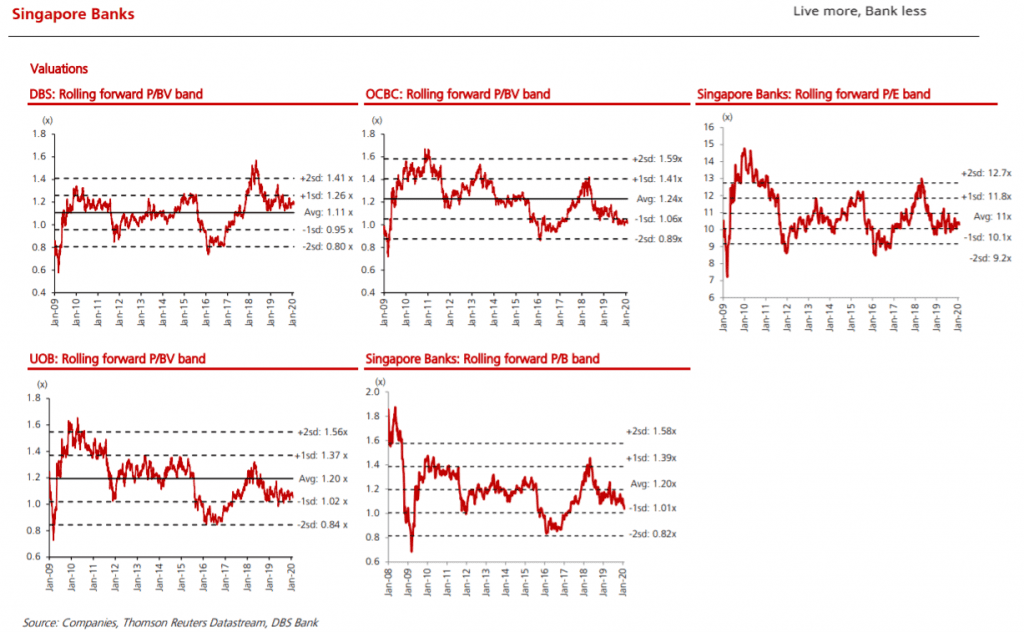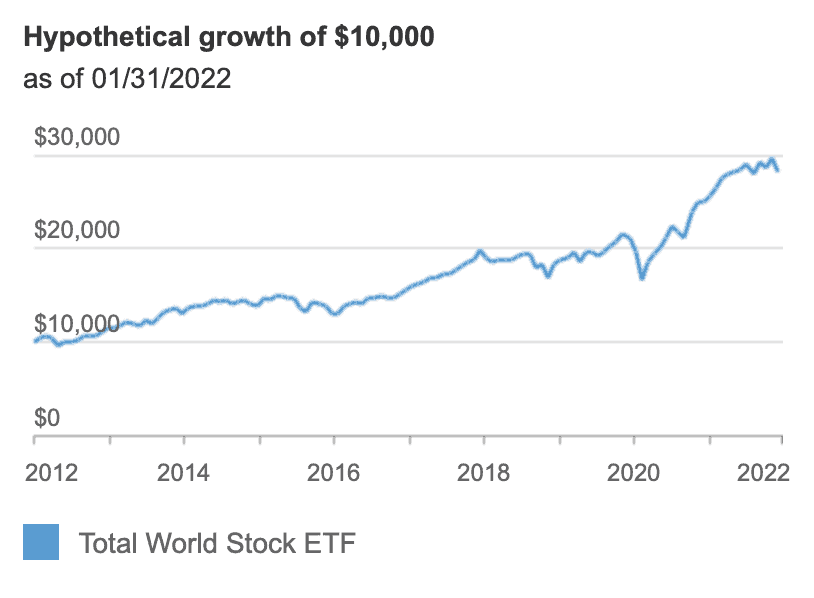Work shapes a third of our lives. If you’re unsure about how to genuinely feel […]
Here's my concise notes after learning about how we can build a Winning Portfolio, from Adam Khoo's Value Momentum Investing Course. These are some useful concepts that I jotted down while going through the online modules.
Part 1 | Part 2 | Part 3 | Part 4 | Part 5 | Part 6
Part 1: Portfolio Construction
Diversification is needed to achieve low volatility and high returns in a portfolio.
Principles to build a Winning Portfolio
- Divide your capital into 8-30 stocks
- Diversify between countries, sectors and stock categories
- Divide your capital between core long term investments
- For speculative investments, you can allocate 1/2 of a normal position or less
- Balance your portfolio such that each stock will eventually take equal percentage of your total capital
- Do not have more than 25% of your portfolio concentrated in a sector
Add shares of a particular stock if it is
- Undervalued (price below intrinsic value)
- Price has retraced down to a support level
- Not yet at a full position in your portfolio

Part 2: Sector breakdown
Defensive Stocks
- Defensive companies sell product or services that are necessities
- They make consistent sales and profits despite the economic cycle
- Low to moderate growth of 5-10%
- Outperform during economic downturn and underperform during economic cycle
Strategy
- Buy defensive stock during economic boom: J&J, United health, Pepsi, P&G
- You want to do the opposite of others
- During recession: majority usually buy defensive stocks such as Pepsi, Clorox, Unilever, P&G and Coca-Cola. After recession: buy cyclical stocks.
US sector stocks (defensive)
Healthcare (XLV): JNJ, PFE, UNH, WLP, ABT
Consumer staples (XLP): PG, PEP, CL, KO, KMB
Utilities (XLU): DUK, EXC, NEE, D, SO
Cyclical Stocks
- Companies that sell products/services that are dependent on the economic cycle
- Generate high sales & profits during economic boom
- Underperform during a recession, outperform during economic boom
- During economic boom, cyclical stocks lead the way and underperform during recession
Strategy
- Buy cyclical stock during economic downturn: JP Morgan, Bank of America, 3M, UOB, DBS & OCBC
- Buy these stocks at the bottom of the cycle
- Sell when they r overvalued (during economic boom)
- Can consider Ping An insurance, Mastercard (>Visa)
US sector stocks (cyclical)
Basic materials (XLB): DOW, NUE, AA, DD, MON
Finance (XLF): MA, JPM, BAC, GS
Energy (XLE): COP, CVX, BP, XOM
Real estate (XLRE): REG, EXR, IRM, ESS
US sector stocks (moderate cyclical)
Such stocks have consistent profit and sales.
Can look into Home depot, Cosco, Nike, Amazon, Target, 3M, Boeing & Lockheed Martin
Netflix is in a competitive scene as there is Amazon Prime etc
Technology (XLK): Aapl, msft,crm,adbe,pypl
Industrials (XLI): DE,MMM,CAT, BA
Consumer discretionary (XLY): HD, TG,LOW,NKE,AMZN,EBAY
Communication services (XLC): FB,NFLX,GOOGL,DIS,T
Investment categories
- ETFs
- Large growth
- Predictable
- Cyclical
- Speculative growth
- Turnarounds
- Dividend
- Deep value
Dividend cash cows/Income stocks
- For the objective of earning dividend
- Singapore REITS are in this category
- Do not invest based on high dividend yield
Criteria for dividend stocks
- Dividend yield at least 4-5%
- Consistent increase in dividends per share, net income, CFO for past 5 years
- Stable or increasing share price for past 5 years
- Defensive stocks (avoid cyclical stocks like airlines, commodities, shipping, property etc)
- Conservative debt (debt servicing ratio <30%)
- Dividend payout ratio between 20-100% (If it is more than 100%, means company paying out dividend more than what its profit (not sustainable)
Formulas
- Dividend yield = dividend per share/price per share *100%
- It is possible that dividend yield is high but DPS is falling (because share price is falling more than DPS)
- Payout ratio = dividend per share/earnings per share *100%
Large Cap Predictables
- Products/services that you use regularly, never goes obsolete and tends to be defensive
- Large companies that have wide economic moats, predictable earnings and cash flow from operations
- Low uncertainty in earnings, cash flow and volatility
- Slow but steady capital appreciation
- Growth rates usually 5-10% per year
- High returns can be achieved when bought at big discounts (during crisis/ face temporary problems), combined with selling covered call options
- Examples: YUM, CL, PG, UNH, JNJ, Clorox, Macdonalds
Large Cap Growth
- Large companies that still have high growth potential (>20-25%). Example: Domino
- Majority tend to be technology related companies or in secular growth industries (Cybersecurity, E Commerce, Software)
- Stock price is usually overvalued but investors need to be patient and enter at undervalued levels during temporary bad news or crisis
- Growth companies could either have a wide economic moat (brand monopoly, high switching costs, network effects) that lasts for decades or a narrow economic moat (small competitive advantage, shorter term)
- Wide moat: googl, amzn, fb, baba, tencent, msft and adbe
- Narrow moat companies are more risky - take smaller positions
- Narrow moat: nvda, ulta
Speculative Growth Stocks
- New growth companies that may have the potential to become large wide moat stocks that will dominate their industry
- They may currently have a narrow economic moat now
- Sales revenue growing at >100% but yet to have consistent net income and CFO.
- Company may still be making losses due to high investment costs and lack of EOS
- Example: Zoom, Meituan, Beyond meat and Snowflake
Strategy
- Use PSG as valuation method (PSG should be 0.2 or less)
- High risk investment hence
- Recommend to take smaller position in such stocks (less than 0.5 of a usual position
- May cut losses if stocks turns into a downtrend or 25% down from purchase price
Deep cyclical stocks
- Companies that are in capital intensive industries
- Highly sensitive to the economic cycle and are unable to respond to demand changes quickly
- They make significant profits during Economic booms and smaller profits or even losses during Economic recessions
- Example: banks, real estate developers, industrials, offshore, marine and commodity companies
Strategy
- Buy deep cyclical stocks only when they are near the bottom of their cycles and sell to take profits when they are at the top of their cycles
- Bottom of the cycle
- Generating low profits or temporary losses.
- Very undervalued
- Price is near support levels of long term chart (weekly and monthly candles)
- Can buy for short term opportunity
- Top of the cycle
- Generating high profits
- Overvalued
- Price is near the resistance level of long term chart

Deep value stocks
- Stocks selling for less than the net cash on their balance sheet
- Buying distressed companies (industry recession) that are selling below their net working capital (current assets-current liabilities) less long term debt
- Examples: BSH, CXS, FLXS, GENC, MPAD, OPST, PARF & TNAK
Deep value stocks criteria
- Positive CFO for past 12 months
- Conservative debt
- Current ratio >1
- Debt to equity ratio < 1
- Debt servicing ratio > 30%
- Share price< [(CA-CL)- long term debt]/ shares outstanding Accumulate at support levels of consolidation or the reversal into an uptrend (50MA>150MA, both MA flat or sloping up)
Exit strategy: exit when 50MA crosses below 150MA (both MA flat or sloping down) or when company reports a quarterly loss
Turnaround Stocks
- Great busineses that have been temporary hit by bad news (lawsuit, boycott, scandals, mismanagement, recession etc)
- Company may be making temporary losses but their economic moat remains intact
- Stock price can sell at 40-50% below intrinsic value
- Patience needed in waiting for these stocks to recover and "turnaround"
- Examples: Yum, Booking, Boeing
Strategy
Only go for wide moat industry leaders
Index, Sector and Industry ETFs
- No company specific risks
- Focus only on technical analysis (trends, MA, support/resistance)
Strategy
- Can buy ETFs when there are too many good companies in the sector (not a single company dominate the industry) or when it is too risky to buy one company
- Buy when the undervalued sector is hit by temporary bad news
- When to buy: DCA or buy dips on uptrend
Related article
VTI vs VOO: which index fund is a better investment (updated 2020)
Thank you for reading! Please like my Facebook page to get the latest updates.







